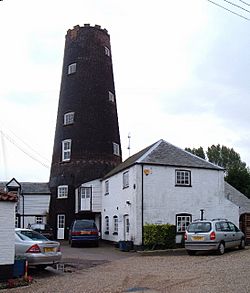Gayton Windmill, Norfolk facts for kids
Quick facts for kids Gayton Windmill |
|
|---|---|

The mill in 2006
|
|
| Origin | |
| Mill name | Gayton Mill |
| Grid reference | TF 7322 1927 |
| Coordinates | 52°44′36″N 0°33′53″E / 52.743356°N 0.564771°E |
| Operator(s) | Private |
| Year built | c1824 |
| Information | |
| Purpose | Corn |
| Type | Tower mill |
| Storeys | Eight storeys |
| No. of sails | Four sails |
| Type of sails | Patent sails |
| Windshaft | Cast iron |
| Winding | Fantail |
| Fantail blades | Six blades |
| Auxiliary power | Steam engine, later a paraffin engine then a diesel engine |
| No. of pairs of millstones | Three pairs, plus a further three pairs driven by auxiliary engine |
| Size of millstones | One pair Peak stones 4 feet (1.22 m) diameter, one pair French Burr stones 4 feet 2 inches (1.27 m) diameter. |
| Year lost | Truncated post 1937 |
For the Gayton Windmill now in Merseyside see Gayton Windmill, Cheshire
Gayton Mill is an old windmill located in Gayton, Norfolk, England. It is a special type called a tower mill. This building is listed as Grade II, meaning it's an important historic place. Today, part of the mill has been removed, and it is used as a place for people to stay.
Contents
History of Gayton Mill
Early Days of the Mill
Before the tower mill, there was a different type of windmill here. This was a post mill, which stood at Gayton in 1797. It was even shown on an old map of Norfolk from that time. The post mill was put up for sale in 1815 and again in 1819.
The tower mill you see today was built around 1824. It also appeared on the first Ordnance Survey map of Norfolk. A person named Robert Matthews was the miller in 1836. A miller is someone who operates a mill to grind grain.
Changes and New Power
In 1872, the mill was available to rent. By this time, a steam engine was also being used. This engine helped power three extra pairs of millstones. These millstones were used to grind corn.
Edward Lewis took over the mills. He had worked at a watermill before. The mill was sold by auction in 1873. Edward Lewis bought it and kept it in his family for many years.
Modern Era and New Uses
In 1919, a company called Gayton Mills Co Ltd was formed. Around this time, the mill stopped using wind power. Instead, a paraffin engine provided the power. Later, a diesel engine replaced the paraffin engine.
The large sails of the windmill were removed around 1925. The mill continued to work with engine power until 1937. By 1949, the mill was no longer in use and was falling apart.
The top part of the mill, called the cap, and the top floor were removed by 1980. The mill buildings were then sold privately. The new owners turned the mill into a place for crafts and homes. They also hoped to put the cap and sails back on.
In 1987, the mill was approved to be used for holiday stays. Today, it is used as a special kind of home for people who need extra care and support.
How Gayton Mill Was Built
Gayton Mill was a very tall building. It had eight floors, or storeys. There was a platform, or stage, on the third floor. The bottom of the tower was about 22 feet (6.7 meters) wide inside. Its walls were very thick, about 2 feet (60 centimeters) thick.
The mill had a special roof called an ogee cap. A fantail with six blades helped turn the cap to face the wind. It also had four Patent sails, which were advanced for their time. These sails turned three pairs of overdrift millstones to grind grain.
Today, the tower is shorter. One storey has been removed. The top of the tower now has a decorative, castle-like edge.
Millers of Gayton Mill
Many people worked as millers at Gayton Mill over the years:
- Robert Matthews (1836-1846)
- Walter Hall (1853-1872)
- Edward Lewis (1872-1892)
- Henry Lewis (1896-1900)
- Alfred Lewis (1898-1919)
- Alfred Littleproud (1901)
- Gayton Mills Co (1912-1919)
- Gayton Mills Co Ltd (1919-1937)

